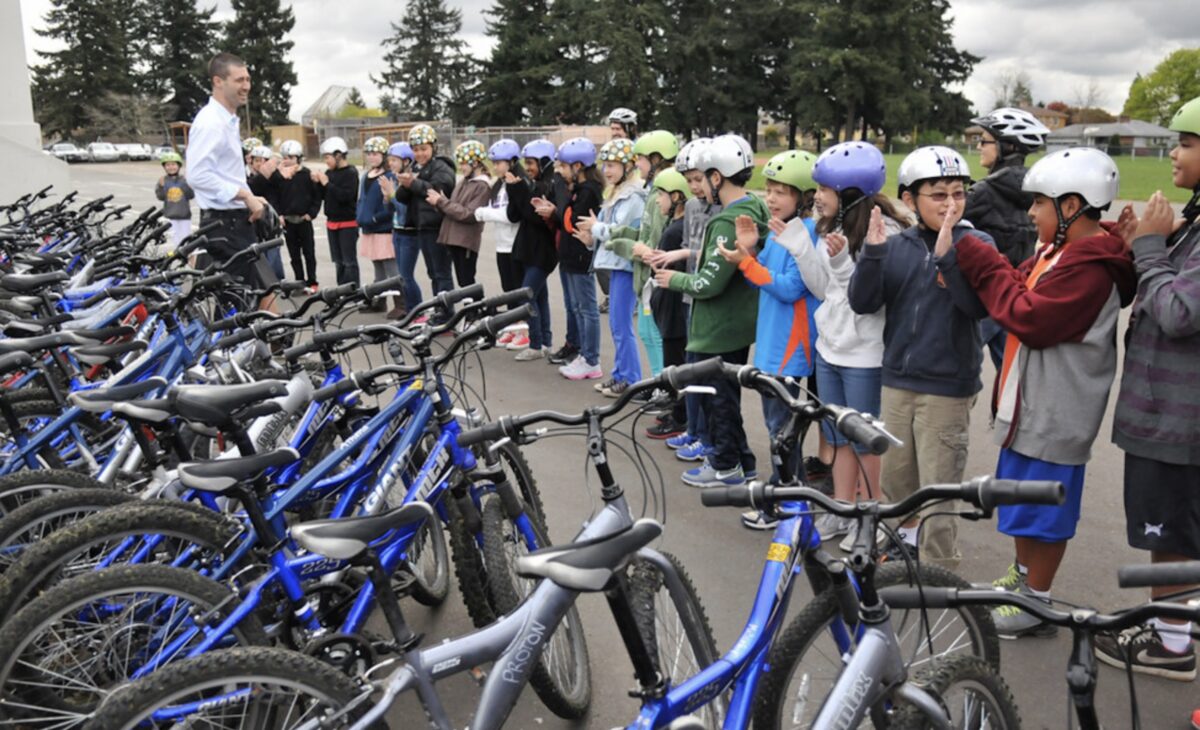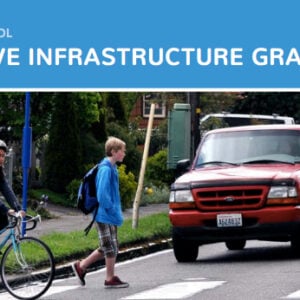
(Photo: J. Maus/BikePortland)
As classes begin for thousands of students around Oregon today, schools around the state will get a bit safer thanks to $2.3 million in projects announced yesterday.
The Oregon Department of Transportation has awarded grants to 11 recipients as part of a federally funded non-infrastructure program. None of the winners were in Portland, but funds will go toward programs in our region including east Multnomah County and Beaverton.
ODOT’s Safe Routes to School program focuses on two categories of projects: infrastructure and non-infrastructure. The non-infrastructure program, “focuses on awareness and safe use of walking and rolling routes.” For the 2020-2022 funding cycle they received 28 applications. To whittle down the list to 11 they ranked each project on five principles: safety, equity, communication, collaboration and coordination.
While City of Portland projects scored high, ranking criteria favored new applicants (the Portland Bureau of Transportation’s Safe Routes program is much more developed than other cities throughout the state).
Below is the list of 11 projects that will receive funding:
1. Beaverton School District $243,719
The project includes hiring a coordinator, teacher training, crossing guard training, and encouragement activities. This project will focus primarily on the fourteen Title 1 schools and those schools facing transportation and district boundary changes. The School District will work with the City of Beaverton and Washington County to update and prioritize needed projects throughout the district to create more walking and rolling opportunities to school and throughout the neighborhood.2. City of La Grande $147,400
This project is to fund a coordinator that will be employed through the City of La Grande Parks and Recreation Department to develop and implement a SRTS program. Working in coordination with the La Grande School District, the coordinator will develop and implement SRTS Action Plans for Central Elementary School, Greenwood Elementary School, and La Grande Middle School. The project goals that will be identified through the SRTS Action planning process will seek to encourage more students to walk and roll, and to increase student safety through enforcement activities, education of safe bike/ped practices, and collaboration with community partners to develop a sustainable education and pedestrian safety program.3. Commute Options $ 179,353
This project includes SRTS programming for twenty schools in Jefferson County, Sisters, Redmond, Bend LaPine and Crook County school districts. This expands on previous SRTS work to build in levels of local sustainability by transitioning to train-the-trainer P.E. and Health bike/ped education model. Project deliverables include: Action Plans, community partnerships and coalition building, train-the-trainer bike/ped education program, walking school bus, encouragement events, program evaluation and data collection.Advertisement
4. Douglas Education Service District $244,995
This project includes hiring a .5 FTE SRTS County Coordinator and a full time AmeriCorps member. Both of these positions will work together as local SRTS promote student safety as they arrive and depart from school, with activities and education offered through the leadership of school staff, parents and volunteers. Participating districts include 9 of the 13 districts served by the Douglas Educational Service District. These districts and schools range from the smallest, located in the very rural areas of Douglas County, to our largest district comprised of neighborhood schools. Programming will involve community coalition building, data collection, action plans, encouragement events and in school bike/ped education.5. Grants Pass School District $100,442
This project is a collaboration between Grants Pass School District 7, the City of Grants Pass, and the Grants Pass Blue Zones Project. The project will identify barriers, both real and perceived, that discourages walking and biking to schools, complete a SRTS action plan, and implement a P.E. pedestrian and bicycle safety curriculum at the District’s elementary schools and middle schools. There are six K-5 elementary schools and 2 middle schools in our district: Lincoln Elementary, Allen Dale Elementary, Highland Elementary, Parkside Elementary, Redwood Elementary, and Riverside Elementary, North Middle and South Middle. The goal is to develop a sustainable equity based, District-wide Walk and Roll Safety Program to promote a healthy lifestyle as well as build personal responsibility for road safety.6. Lane County $300,000
This application is for a three-year project to establish an ongoing SRTS Rural Program for rural schools by hiring a SRTS Rural Coordinator. The project aims to provide SRTS bicycle and pedestrian safety education to every rural elementary and middle school in Lane County. The first year will focus on developing the program and building relationships with the schools through the creation of Action Plans. The second year will focus on adapting available curriculum to meet the unique needs of the schools and acquiring equipment to host bike rodeos at the schools. The third year will focus integrating bicycle and pedestrian education into the school curriculum such as by training PE teachers. Pop-up encouragement events, such as bike rodeos will be held at schools each of the three years to gain momentum and excitement for the program, solicit sponsors and volunteers, and build social capital.7. Medford School District $ 300,000
This project is to hire a full time Safe Routes to School coordinator position to work with the Medford School District. The Coordinator will also consult with The City of Medford and Parks & Recreation regarding will build relationships with all stakeholders and partners. The goal is to develop a sustainable, ongoing program for the District. The Coordinator position will be a resource, catalyst and conduit for Safe Routes to School activities in the Medford School District area and will be the person conducting bike/ped education or encouragement activities. Deliverables will include Action Plans, data collection, and training of crossing guards, encouragement activities, and development of bike/ped education in school, and training parents and other community partners.8. Mid-Willamette Valley Council of Governments- Salem-Keizer School District $300,000
This project is to hire a SRTS coordinator to work with schools in the Salem-Keizer School District area. The SRTS coordinator will be located at the school district offices and receive support from school administrative staff as well as the members of Salem Area Safe Route to School Steering Committee. Action Plans will be developed and implemented, starting with five elementary schools in the district and three to four additional schools as resources allow. District-wide walking and rolling events will be also developed and implemented, as well as specialized safety educational and encouragement activities.9. Multnomah County Transportation Planning and Development $300,000
The East Multnomah County Safe Routes to School (SRTS) grant will provide funding to supplement a full-time Program Coordinator for three years to serve East Multnomah County. This area consists of 3 school districts, Centennial, Gresham-Barlow, and Reynolds, and four cities, Gresham, Wood Village, Fairview and Troutdale. A dedicated coordinator will provide programming to schools, after school organizations, and community events. Programming efforts will build upon the previous SRTS work that has been conducted to improve active transportation choices for students and families in East Multnomah County.10. Sky Lakes Medical Center Foundation $100,140
This three year proposed project will focus on the Klamath Falls City School District (KFCSD) schools: Conger Elementary School, Pelican Elementary School, Roosevelt Elementary School, Mills Elementary School, and Ponderosa Jr. High School. Project includes a .5 FTE SRTS Coordinator to work with community partners to utilize the SRTS Master Plan, create school action plans, and implement curriculum for the safety of students who walk and roll and encourage all students to actively commute.11. Sweet Home School District $75,827
This project will serve the five District elementary schools and the junior high school. The project involves hiring a SRTS coordinator and bike safety instructor. Two schools have action plans that need to be updated and the Action Plans will be developed for the remaining schools. Major components of the project are plans for 5th grader P.E. bike instruction and a variety of walk and roll activities for other grades, develop an online forum for volunteers, students, and teachers, training staff and volunteers, and program development and evaluation.
Becky Gilliam, Pacific Northwest Regional Policy Manager for the Safe Routes to School National Partnership said in an email to BikePortland this morning that these grants are crucial for many communities that haven’t had the support to get a program off the ground. “While Safe Routes to School programs in metropolitan regions continue to grow and thrive… we get to see statewide grant funds shift to prioritize lifting up communities who have been historically left out, including those in low-income and rural areas.”
— Jonathan Maus: (503) 706-8804, @jonathan_maus on Twitter and jonathan@bikeportland.org
Never miss a story. Sign-up for the daily BP Headlines email.
BikePortland needs your support.






Thanks for reading.
BikePortland has served this community with independent community journalism since 2005. We rely on subscriptions from readers like you to survive. Your financial support is vital in keeping this valuable resource alive and well.
Please subscribe today to strengthen and expand our work.
Not sure how I feel about this. Maybe some grantees will use the funds to educate all the parents rather than the students, and get them to understand that protecting their kids in cages creates a problem. Then hire a couple of those parents to lead a bike train.
So, you’ll probably want to start with budgeting for a full-time coordinator or two to run the program and work with those 60 schools, and supplies for things like bike to school day, bike fairs, and other promotional events. There are about ~60 schools in the Beaverton School District, which would give you, say, $2150 per school. Every school probably has 5 routes to have a train from. If you have 2 adults per train, that’s $200/year. Do you run background checks on these paid employees? What is their legal liability for protecting these kids on the way to school?
Agreed. Way to complicated. Let’s cancel the whole thing.
I’ve heard they actually DO pay parents to run walking trains in Bend, at title one schools where it’s harder to drum up parent support. I don’t know how many or how much…I’d be interested to know what it takes. My general point is that $2.3 million dollars is something, but it’s certainly not enough to overtake the ‘drive your kids to school’ culture that has embedded itself in the US over the past 20-30 years, in every school in Oregon. Is paying parents to walk to school going to make a big dent? Could be?
When I’ve been to these meetings with parents, they start with ‘how many of you walked to school as a kid’? And everyone raises their hand. ‘And how many of you let your kid walk to school?’ Hardly anyone raises their hand. In another generation, we won’t even have parents who have walked to school as kids.
Personally, I’d be a fan of more drastic steps, like shutting down the roads in a perimeter around the school. Start with forcing people to walk two blocks, and then see where it goes. But I can tell you that at our school when they cut 3 buses, the first thing the principal did was to have the parking lot repainted to make drop off more efficient, and make sure the back door to the school was locked during morning arrivals. She did ZERO to encourage walking/biking, and put it all on SRTS.
Just wanted to mention that for at least the Beaverton School District, they run background checks on all volunteers, so I imagine they’d do the same for paid positions.